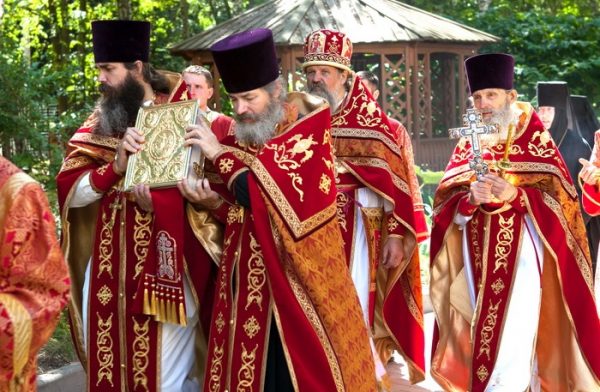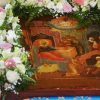One of the first things that clergy do after entering the church on Sunday morning for Divine Liturgy is to put on special clothes called “vestments”. They are highly stylized and every priest wears the same things: first the priest puts on a long vestment called a stichar or sticharion, usually white in colour, which falls down to his ankles; then he puts on his stole which hangs down his chest to knees. Then he puts on a belt, then cuffs. Then over all these he puts on a large vestment called a phelon or phelonion, which comes down to his knees at the back and just down past his chest at the front. With each piece he quietly recites an appropriate verse from the Bible (e.g. “Blessed is God who girds me with strength” when he puts on the belt).
The vestments can simple and simply adorned, or heavy with brocade, and richly adorned. But all Orthodox priests put on the identical vestments every Sunday—i.e. every priest wears a stichar, a stole, cuffs, etc. These are liturgical vestments; they would never be worn when visiting a parishioner, much less for secular duties, such as mowing the lawn. After the Liturgy, the vestments are carefully put away and stored in the altar area at church.
Simple souls who delight in finding Biblical precedent for everything the Church does or who imagine that the Church’s practice has never altered from the days of the apostles, sometimes try to find precedent for the church vestments in the Old Testament. They point to the special vestments of the high priest and the priests in the Old Testament and suggest that the church’s vestments are continuations of these. (Such people also sometimes try to find historical precedent and continuity in the church’s architecture, and suggest that the church’s three-fold architecture of altar-nave-narthex comes from the Temple’s three-fold architecture of Holy of Holies-Holy Place-and courtyard. It doesn’t.) In fact, the church’s vestments do not reach back to the days of the apostles, much less to the days of Moses.
The priests of the Temple indeed wore special vestments when serving at the altar, but the Christian clergy (the apostles and presbyters) did not. They came to the Christian assembly and prayed there in their ordinary clothes. Given the importance of the Eucharistic assembly, no doubt they came in the best clothes they had (the emperor Julian the Apostate tried to mock them by pointing out how they dressed up to worship God), but those clothes would have been also worn at other special non-church occasions as well.
The average bishop in those pre-Nicene days and even afterward wore the clothing of any upper class gentlemen: a linen robe with close sleeves called a linea, covering the whole body from neck to feet, and a tunica over top of that with short sleeves, and then over both of them a paenula, a large round piece of clothing with a hole in the center for the head to pass through, which fell in folds over the shoulders and arms and draped the body down to the knees.
As Dix points (in his The Shape of the Liturgy), this was what bishop Cyprian was wearing in 258 when he was martyred. As history records, when he arrived at the place of his martyrdom Cyprian took off his paenula, folded it up, knelt down on it and prayed. He then took off his tunica, handed it to his deacons, and stood up in his linea to await execution. Later generations might look back to the martyr and his clothing and conclude that he was wearing a phelon which he folded, and finally stood up in his stichar—the special vestments he wore only when serving Liturgy. In fact, he was wearing the normal outside clothing that any Roman gentleman wore.
What happened, of course, is that fashions in the world changed, as the clothing worn by the new barbarians became fashionable. The Church however, conservative as ever, kept the fashion that had been used in antiquity. When the emperor Constantine donated to the cathedral church at Jerusalem “a sacred robe” of gold tissue to be worn by the bishop when presiding at Paschal baptisms, he was simply donating a very fancy piece of clothing—the ancient equivalent of an Armani suit.
Far from the clergy always vesting in special clothes when they presided at worship, the introduction of special clothes was greeted with opposition and some hostility. The first vestment to be used especially in church was a scarf, usually made of coloured silk. As Dix wrote, “This was the old ‘scarf of office’ worn by the emperor and consuls, a badge granted to numerous other officials during the fourth century. It was adopted by the clergy in various forms…For the lower clergy it becomes the ‘stole’ worn in different ways by bishops, priests, and deacons as a badge of distinction”. Bishops wore it in one way (now seen in the modern episcopal omophorion), priests in another way (the modern stole), and deacons yet another way (the orarion worn over the left shoulder). The clergy in those days wore it as a mark of distinction.
But as said above, not everyone in those early days approved of it. An early bishop of Rome in about 425, Celestine, emphatically did not approve. He learned that some bishops in Gaul (i.e. modern France) were adopting this fashion and he wrote to rebuke them in no uncertain terms: “It is small wonder that the church’s custom should be violated by those who have not grown old in the church, but entering in by some other way have introduced into the church along with themselves things which they used to wear in another way of life [i.e. when they were civil magistrates]. Whence came this custom in the churches of Gaul, so contrary to antiquity? We bishops must be distinguished from the people and others by our learning, not by our dress, by our life, not by our robes, by purity of heart, not by elegance”.
Ouch. One can, however, sympathize with the papal point of view: the true adornment is internal, not external. Pomp and frippery, the pope said, have no place in the church, for such externals can overwhelm the internal, stealing focus from where it belongs.
However, as anyone can see, eventually all the churches, west and east, came to use special vestments while serving Liturgy, and now the sight of clergy serving in a nice secular suit would be spectacularly jarring. Though the development from secular dress to liturgical vestment may have been gradual and in some ways unintentional, it has been the custom of the Church for about a thousand years.
The question may be asked: since the custom is not apostolic (as Pope Celestine pointedly reminded his northern colleagues), could we change the custom? If St. John Chrysostom served Liturgy in a nice Armani suit (or knowing Chrysostom’s disdain for pomp at the capital, more probably in a nice sport coat from Walmart), why can’t we clergy today serve the Liturgy of St. John Chrysostom in secular clothing? It would certainly serve to counteract clericalism (a good thing), and put the main focus on the internal person of the heart, and not on dress, robes or elegance.
The problem with changing the current custom by returning to an older one is that history has no reset button, no rewind switch. In a word, changing from church vestments to secular clothes is not the same thing as retaining secular clothes. That is because there is more at stake in this change than simply the kind of clothes on one’s back. Clothing, like everything else in history, tends to accumulate significance, and the fact that the accumulation is accidental and unintended is irrelevant. Like it or not, the change of custom regarding vestments now involves more than merely choice of dress.
We see this clearly enough from a quick backward glance at the Reformation. By the sixteenth century, church vestments had accumulated theological significance. Priests wore them when officiating at the Mass, and so, along with the Mass, vestments had to go when the Mass was rejected. And not just vestments—everything that reminded the Reform-minded of the Mass had to go: vestments, incense, candles, the cross, statues, pictures, palms on Palm Sunday, and ashes on Ash Wednesday. The English Puritans even wanted the ring gone from the wedding service. Some churches maintained vestments of a sort, (such as the academic or “Geneva” gown), but anything that savoured of the Mass and the old ways had to go. That included vestments.
We can also see this today. Sometimes Baptists and Pentecostals might argue against the use of vestments, saying “vestments don’t matter”. If you think they don’t matter, try this experiment: have the Baptist or Pentecostal minister show up for services next Sunday wearing Roman Catholic eucharistic vestments and see what happens. It will immediately become apparent to every Baptist or Pentecostal in the room that, as it turns out, vestments do matter, and that the minister better take them off right away. And never again put them on.
Church vestments, like every other cultural artefact, have accumulated significance as time progressed. Vestments now all come invisibly laden with history, and therefore with hidden and perhaps unacknowledged approaches to Christian life and spirituality. Using a Rosary, like it or not, brings with it a long history of Catholic devotion—and not just Marian devotion, but the entire Catholic world in which that devotion first arose. Using the Sankey & Moody hymnbook Sacred Songs and Solos to sing hymns like “I’ve found a friend in Jesus” or “Rock of ages, cleft for me” similarly brings with it the entire world of Evangelical fervour, spirituality, and soteriology, whether you intend it to or not. (This is not unrelated to the issue of Western Rite, which we will not here discuss.) It is the same with Orthodox vestments: they also bring with them the world and entire theological approach of the historical Orthodox Church.
Thus, jettisoning vestments is not at all the same thing as not having vestments. St. John Chrysostom didn’t have special vestments, but his non-use of them did not involve jettisoning something which he had. Getting rid of vestments today would involve jettisoning something that we have, and would thus be making an important statement about more than simply vestments. We would be making a statement about and rejecting many things in our tradition—things which are now expressed by our use of vestments. If we would retain these precious things in tradition (such as the solemnity of worship, the sacrificial and sacramental nature of the Eucharist, and the authority of clergy in parish life), vestments are here to stay. And I suspect that St. John Chrysostom would understand and approve.

















